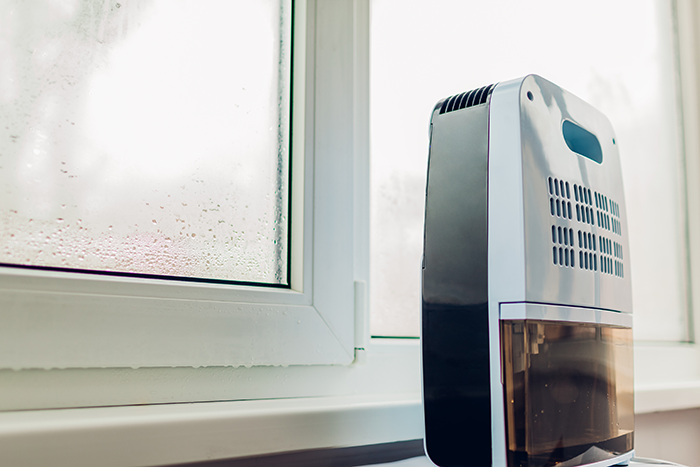Condensation on windows: causes, prevention and how to stop it
Have you ever woken up to find a thin layer of fog on your windows and used a finger to wipe it away, watching tiny droplets collect and run down the glass? This is condensation on windows and we are going to look at what causes it, how to prevent it and how to stop it if it’s already a problem for you.

What is condensation?
Condensation is the reaction that happens when warm, humid air meets a cold surface. The water that is present in the air converts from vapour to a droplet. We often see this on windows, mirrors, glasses, cans or bottles.
While condensation itself is natural and harmless, if it is forming on your windows it can be cause for concern. Not only does it present an aesthetic problem (you can’t see clearly out of your beautiful windows!), but it can be a sign of excessive humidity in the air. High levels of humidity left unchecked can lead to mould, fungus, or even the degradation of building materials. This is why it is important to think about what the condensation on your windows could be telling you about your space.
What causes condensation on windows?
This phenomena occurs when the air on one side of the window becomes warmer or more humid than the air on the other side. We see the most condensation on windows in winter, particularly in rooms with more moisture circulating such as kitchens and bathrooms.
There are three types of condensation on windows:
Condensation on inside of windows
Also known as room side condensation, this occurs most frequently in the winter months when temperatures outside drop below temperatures inside. You can test to see if you have room side condensation very easily, just use your finger! If you can wipe away the fog from inside a window, the condensation is being caused by humidity inside the room. Additionally, if more than one window is showing condensation, it’s unlikely that the problem is related to individual seals. In this case, it’s likely that the culprit is indoor humidity.
Condensation on outside of windows
This is also known as reverse condensation. It usually occurs in the summer, when it’s possible for temperatures inside the house to become cooler and less humid than temperatures outside. It typically occurs during the transitions between cool nights and warm days, and is the type of condensation we often wake up to in the morning.
Condensation between window panes
This type of condensation forms when warm air and cool air meet between the panes of glass and is a sign that there is a problem with your window construction. Moisture in this area means the sealant has failed, exposing warm air to cool air. In order to fix this, the windows will have to be resealed or replaced.
There are also different factors that can contribute to increased humidity in the home:
- Gas and propane
release a lot of moisture when they burn, so using a fireplace can increase the moisture level in your
home if you use it often
- New building
materials such as concrete or wood can take upwards of one year to fully dry and condensation should be expected through the first heating season
- Bay or bow windows
are more susceptible to condensation because they project beyond the insulated wall and make a
insulated barrier more likely to form
- Insulated
drapes and tighter shades can restrict air flow over window glass
If you can’t diagnose the cause of the condensation on your windows, talk with a local building inspector about the moisture problems common to your area or ask for a home inspection and diagnosis. Moving quickly with the right specialist can prevent damage to your home, so it can be a smart investment!
My windows are new and there is even more condensation than before! What’s going on?
When they are properly installed, new windows create a more efficient barrier to air exchange in and out of a home. A better barrier means more of a stark difference between the inside and outside air temperatures. Combined with existing levels of humidity, this can actually result in more condensation in newer windows! It is a sign of higher energy efficiency, since it means the outside pane is insulated from the heated indoors of your home.
 What risks
are associated with condensation on windows?
What risks
are associated with condensation on windows?
Condensation on windows is not harmful and is the result, not the cause, of humidity in the air. It becomes risky when it accumulates and water trickles down into the window frame, surrounding fabrics (such as window treatments, or rugs), flooring or drywall. Over time, excess moisture in these areas causes blistering, cracking or peeling of paint and the denigration of building material.
Additionally, the high levels of humidity that cause condensation can create a hospitable environment for bacterial growth, mold and mildew. It is possible to develop health problems related to this, such as:
- Irritation of the throat, eyes and nose
- Cough and mucus buildup
- Shortness of breath
- Wheezing
- Worsening of an existing respiratory condition (asthma, emphysema, etc.)
How to prevent condensation on windows
The main way to prevent or stop condensation on windows is to reduce sources of excess moisture in your home.
Room by room
Bathroom
- Make sure bathrooms are well ventilated, especially after showers and baths
- To release steam, use a properly installed fan that is vented to the outside of the house while bathing and for 15 - 20 minutes afterwards
- Do not keep wet towels inside the bathroom
- Get into the habit of using a squeegee on shower enclosures after use to encourage water to drain away rather than evaporate into the air
Kitchen
- Use a lid on pots, pans or kettles while cooking to limit steam released into the air
- Use a range hood while cooking and for 15 - 20 minutes afterwards
- Monitor the location of furniture that could be blocking air circulation
Laundry room
- Limit hang-drying unless the area is very well ventilated, as this releases a lot of moisture into the air
- Make sure all ducts for the exterior vents of your dryer are sealed
Basement or crawl space
- Be careful how and where you install wood and fiberglass insulation in basements and make sure they won't see prolonged exposure to moisture or contact with humid surfaces
- Make sure to install vapour barrier on the bottom and outside of concrete, but not on the inside, so it will not retain moisture
- Monitor humidity and improve ventilation
In every room
- Air ventilation: Check windows for any cracks or tears in the sealant that could be letting air in and contributing to temperature-related condensation. Evaluate furniture placement and whether or not there are pieces blocking any vents or inhibiting the free flow of air throughout the home. Check all of your air ventilation systems for possible leaks or blockages, such as closed vents. Keep vents open, filters cleaned and ducts sealed for clear and optimum ventilation in every room. You can also trim shrubbery near windows or doors as this will help promote air circulation.
- Houseplants: Carefully consider what houseplants you have and whether they are contributing to the overall humidity of your space. Plants release moisture into the air as they grow, so move them off your windowsill during the cold season.
- Plumbing: Check all plumbing (including gutters, downspouts and roof coverings) for possible leaks.
- Insulation: Make sure to heat and insulate your home evenly to prevent cold spots that will encourage condensation to form. To combat exterior condensation, you can try leaving window coverings open or raise the temperature setting on your air conditioner in an effort to warm up the exterior glass and reduce the insulation barrier.
- Clutter: Throw out clutter that collects moisture such as cardboard boxes, old clothes or firewood.
Purchase a dehumidifier
Dehumidifiers regulate humidity by drawing moisture from the air. A fan pulls the moist air into the dehumidifier and through cooling coils, which use condensation to draw dampness from the air. The dehumidifier’s heat recovery system then passes the warmer, dryer air back into the room. The water is collected by a hose that drains or pumps out collected water automatically, or a removable reservoir that is manually removed from the unit.

Measure the room’s dimensions to determine the size of dehumidifier you will need. Determine the room’s length and width and multiply to determine its size. Dehumidifier capacity is rated by the amount of moisture removed in 24 hours, so a 10 - 15 litre humidifier is rated to remove 10 - 15 litres of moisture in one day.
According to Natural Resources Canada, a small room is up to 185 metres squared. Here are the recommended capacities for a small room depending on the humidity level:
- 50 - 75% relative humidity: a 10 - 15 litre capacity dehumidifier.
- 75 - 90% relative humidity: a 11 - 20 litre capacity dehumidifier.
- 90 - 100% relative humidity: a 15 - 25 litre capacity dehumidifier.
Don’t forget to buy a dehumidifier model with the highest integrated energy factor (IEF) for best efficiency and to save money on your electricity bill.
Install fans to improve air circulation
Purchase a moisture absorbing product
Also known as desiccant dehumidifiers, these products are designed to remove moisture from the air by using chemicals instead of condensation. They are quieter and good for hard to reach areas. However, they hold a much more limited capacity of water, create more waste and are less economical than other types of dehumidifiers.
The perfect rate of humidity
According to Health Canada, the optimal rate of humidity in the home should be above 30% in winter and no more than 50% in summer (ideally, it should be somewhere between those percent values at all times).
If the condensation is forming from the interior of your home, start by measuring the humidity in the room using a hygrometer, such as the Accu-Temp Humidiguide or AccutempThermo Hygrometer. Measuring the humidity in each room should help you identify what area the moisture is coming from.

Hygrometers measure relative humidity in the air (%), which is the amount of vapour in the air compared to the highest possible amount. The most common hygrometers are mechanical or electric and they are readily available (and relatively inexpensive!) at most hardware, department, or building supply stores.
Utilizing a hygrometer with an integrated temperature reading can be beneficial to monitor both readings at once and observe if changes in heat are what is contributing to the formation of condensation on windows.
Hygrometer: digital vs. analog
Deciding between digital and analog depends on factors such as whether you want to monitor several rooms in your home at once or be able to read the display more easily from afar. Other factors include power source, maintenance, user interface, data logging and access to historical data. However, for most homeowners, a simple battery-powered hygrometer that takes spot readings will suffice.
Many digital hygrometers now come with applications for smartphones (with built-in humidity sensors) or standalone sensors (with USB or wireless connectivity). This makes it possible to receive custom alerts, updates and measure readings even when outside the home.
Testing the accuracy of a hygrometer (the towel test)
If you are unsure as to whether or not your hygrometer is functioning properly, you can perform a simple test to find out.
Thoroughly dampen a towel (not dripping wet, but very damp), then wrap the hygrometer in the towel for 30 to 45 minutes. Once unwrapped, quickly note the humidity reading. If your hygrometer is perfectly calibrated, it will read exactly 100% humidity. Most likely, it will be read somewhere between 80 and 90% (many hygrometers are only accurate within 5%). Whatever the hygrometer reads, you can set the needle to exactly 100% immediately after the test.
Using a hygrometer will help you identify exactly how you should tackle controlling the relative humidity in your home. For more information on how to use a hygrometer, we recommend consulting Health Canada’s publication on measuring humidity in your home.
In conclusion, condensation on windows can be an important signal about what is happening to the windows or humidity levels in the home. Pay close attention and your windows should stay clear for many seasons to come!
Are you passionate about real estate? Subscribe to the Centris.ca newsletter now.
See also:
What should the humidity be in a house
Solutions for moisture in the basement
How to lower radon levels in your home